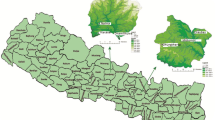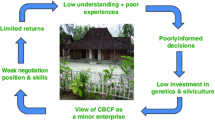Abstract
In many developing countries, especially in Africa, farmers have been introduced to agroforestry with little consideration for the markets for trees and tree products aside from potential productivity gains to food crops. It is now being recognized that expanding market opportunities for smallholders particularly in niche markets and high value products is critical to the success of agroforestry innovations. Some recent work presented in this paper on marketing agroforestry products in Africa, linking farmers to markets and assisting farmer organizations, shows how constraints are tied to both long-standing market structures as well as shifting market imperatives. Forest policy, physical and social barriers to smallholder participation in markets, the overall lack of information at all levels on markets for agroforestry products, and the challenges to outgrowing schemes and contract farming inhibit the growth of the smallholder tree product sector in Africa outside of traditional products. Notwithstanding these constraints, there are promising developments including contract fuelwood schemes, small-scale nursery enterprises, charcoal policy reform, novel market information systems, facilitating and capacity building of farmer and farm forest associations, and collaboration between the private sector, research and extension.
Similar content being viewed by others
References
ASB. 2001. Policy Brief No. 3: Deregulating agroforestry timber to fight poverty and protect the environment. ICRAF, Nairobi, Kenya: Alternatives to Slash and Burn. http://www.asb.cgiar.org/ PDFwebdocs/PolicyBrief3.pdf
Awono A., Ndoye O., Schreckenberg K., Tabuna H., Isseri F. and Temple L. 2002. Production and marketing of safou (Dacryodes edulis) in Cameroon and internationally: market development issues. Forests, Trees and Livelihoods 12: 125–147.
Bates R.H. 1981. Markets and states in tropic Africa: The political basis of agricultural policies. University of California Press, Berkeley, pp. 178 pages.
Bohannan P.J. and Dalton G. (eds) 1968. Markets in Africa: University of Illinois Press, Evanston, IL, 762 pages.
Böhringer A., Ayuk E.T., Katanga R. and Ruvuga S. 2003. Farmer nurseries as a catalyst for developing sustainable land use systems in southern Africa: Part A: Nursery productivity and organization. Part B: Support systems, early impact and policy issues. Agricultural Systems 77: 187–217.
Coulter J., Goodland A., Tallontire A. and Stringfellow R. 2001. Marrying farmer co-operation and contract farming for agricultural service provision in sub-Saharan Africa. From: The Guide to Developing Agricultural Markets and Agro-Enterprises. World Bank, Washington DC, www.worldbank.org/essd/ essd.nsf/Agroenterprise/marrying
Dewees P.A. and Saxena N.C. 1995. Wood product markets as incentives for farmer tree growing. pp. 198–241. In: Arnold J.E.M. and Dewees P.A. (eds) Tree Management in Farmer Strategies: Responses to Agricultural Intensitification, Oxford University Press, Oxford, U.K.
FAO, Forestry Department. 1996. Marketing in forestry and agroforestry by rural people. Food and Agriculture Organization, Rome. 76 pages.
Franzel S., Wambugu C. and Tuwei P. 2003. The adoption and dissemination of fodder shrubs in central Kenya, Agricultural Research and Network (AGREN) Series Paper No. 131. Overseas Development Institute, London, 11 pp.
Gabre-Madhin E.Z. 2002. Getting markets right in Africa: Opportunities and challenges. AICHA Seminar Presentation. AICHA, Africa, African agriculture, agriculture, agricultural growth. Washington DC: International Food Policy Research Institute. http://www.ifpri.org/themes/aicha/gabremadhin0402.pdf
Girard, P. 2002. Charcoal production and use in Africa: What future? Unasylva 211/53: 30–35.
Gold M.A., Godsey L.D. and Josiah S.J. 2004. Markets and marketing strategies for agroforestry products in North America. (This volume)
Harrison G. 2002. Making a difference in South African forestry. Chapter 12 in proceedings of a conference on equitable partnerships between corporate and smallholder partners: relating partnerships to social, economic and environmental indicators sponsored by FAO and CIFOR. 21–23 May 2002, Bogor, Indonesia. Centre for International Forestry Research, Bogor, Indonesia, www.fao.org/DOCREP/005/Y4803E/ Y4803E00.HTM [accessed: 24 Nov 2003]
Hellin J. and Higman S. 2002. Smallholders and niche markets: Lessons from the Andes. Agren Network Paper No. 118, January 2002. ODI Agricultural Research and Extension Network, London. 16 pp.
Holding C., Njuguna P. and Gatundu C. 2001. Farm sourced timber: The restructuring of the timber industry in Kenya-Opportunities and challenges. In: Race D. and Reid D. (eds) Proceedings of the international conference on Forestry extension: Assisting forest owner, farmer and stakeholder decision-making Lorne, Australia. 29 October-2 November, 2001. Joint Venture Agroforestry Program and Agriculture, Fisheries and Forestry-Australia. http://iufro.boku.ac.at/iufro/iufronet/d6/wu60603/proc2001/ holding.htm [accessed December 6, 2004].
Holding-Anyonge C., Carsan S., Mwaura M., Muchai D. and Gatundu C. 2002. Farm sourced timber: the changing structure of the timber industry in Kenya. Linking research, extension and advocacy to address farmers' needs. Agricultural Research and Extension Network (AgREN) Newsletter 46: 11. http: //www.fao.org/forestry/foris/webview/forestry2/index.jsp? siteId=2141&langId=1 [Accessed Nov 2003]
Holding-Anyonge C.H. and Roshetko J.M. 2003. Farmer-level timber production: Orienting farmers toward the market. Unasylva 212/54: 48–55.
Kaaria S. 1998. The economic potential of wild fruits in Malawi. Ph.D. Thesis, University of Minnesota, U.S.A.
Kaimowitz D. 2002. Not by bread alone...Forests and rural livelihoods in sub-saharan Africa. pp 45–64 In: Tapani Oksanen, Brita Pajari and Tomi Tuomasjukka (eds) Forests in Poverty Reduction Strategies: Capturing the Potential. Proceedings 47. European Forest Institute, Finland. http://www.efi.fi/publications/Proceedings/47.html
Kherallah M., Delgado C., Gabre-Mahdin E., Minot N. and Johnson M. 2000. Agricultural market reforms in sub-Saharan Africa: A synthesis of research findings. International Food Policy Research Institute, Washington DC. 104 pp.
Mithofer D. 2003. Socioeconomic factors in the collection and use of indigenous fruits in Zimbabwe. Ph.D. Thesis, Department of Economics, University of Hannover, Germany.
Murray G.F. and Bannister M.E. 2004. Peasants, agroforesters, and anthropologists: A 20–year venture in income-generating trees and hedgerows in Haiti. (This volume).
Ndoye O., Ruiz Pérez M. and Eyebe A. 1997. The markets of nontimber forest products in the humid forest zone of Cameroon. ODI Rural Development Forestry Network Paper No. 22c. Overseas Development Institute, London.
Ramdhani T. 2002. Marketing analysis of Uapaca Kirkiana indigenous fruits in Zimbabwe. Ph.D. Thesis, Department of Economis, University of Hannover, Germany.
Ruiz Pérez M., Ndoye O., Eyebe A. and Puntodewo A. 2000. Spatial characterization of non-timber forest products markets in the humid zone of Cameroon. Int For Rev 2/2: 71–83.
Scherr S. 2004. Building opportunities for small-farm agroforestry to supply domestic wood markets in developing countries (This volume).
Small Woodlands Program of British Columbia 1994. Guide to Agroforestry, Chapter 12: Marketing Agroforestry Products. See: http://www.swp.bc.ca/ Accessed November 15, 2003.
Terray E. 1974. Long distance exchange and the formation of the State: The case of the Abron Kingdom of Gyman. Economy and Society 3: 315–345.
Thomas M.G. and Schumann D.R. 1993. Income opportunities in special forest products: Self-help suggestions for rural entrepreneurs. Department of Agriculture, Agriculture Information Bulletin AIB-666, May 1993. Washington DC.
Utama R., Rantan D., de Jong W. and Budhia S. 1999. Income generation through rehabilitation of imperata grasslands: production of vitex pubescens as a source of charcoal. pp. 175–184. In: Roshetko J. and Evans D.O. (eds), Domestication of agroforestry trees in Southeast Asia: Proceedings of a regional workshop in Yogyakarta Indonesia November 4–7 1997. Forest, Farm and Community Tree Research Reports Special Issue.Winrock International Institute for Agricultural Development, Morrilton AK, USA.
World Agroforestry Centre 2003. World Agroforestry Centre 2001–2, Annual Report: Transforming Lives and Landscapes. ICRAF, Nairobi, 111 pp.
World Agroforestry Centre, 2003. World Agroforestry Center 2004–6, Medium-Term Plan. ICRAF, Nairobi, 147 pp.
Author information
Authors and Affiliations
Rights and permissions
About this article
Cite this article
Russell, D., Franzel, S. Trees of prosperity: Agroforestry, markets and the African smallholder. Agroforestry Systems 61, 345–355 (2004). https://doi.org/10.1023/B:AGFO.0000029009.53337.33
Issue Date:
DOI: https://doi.org/10.1023/B:AGFO.0000029009.53337.33




